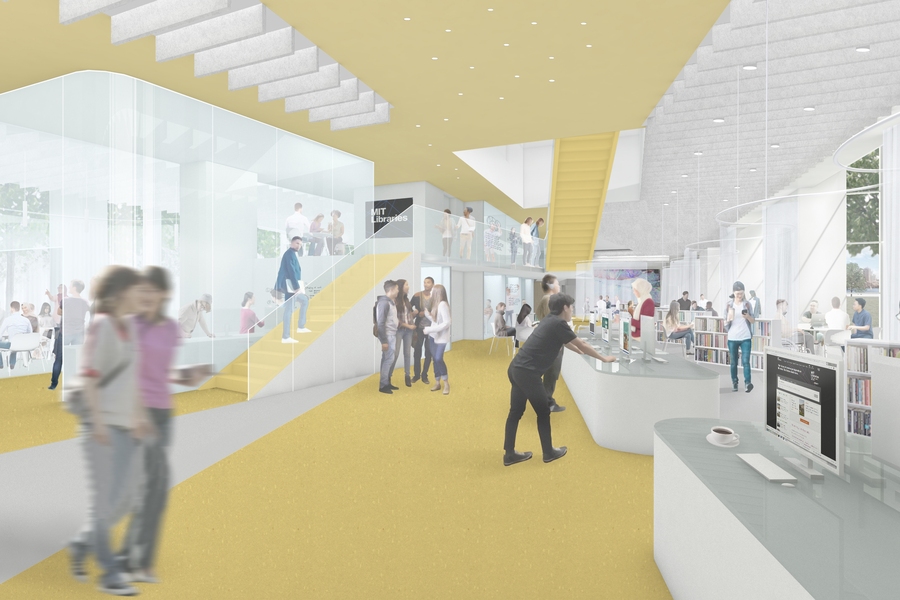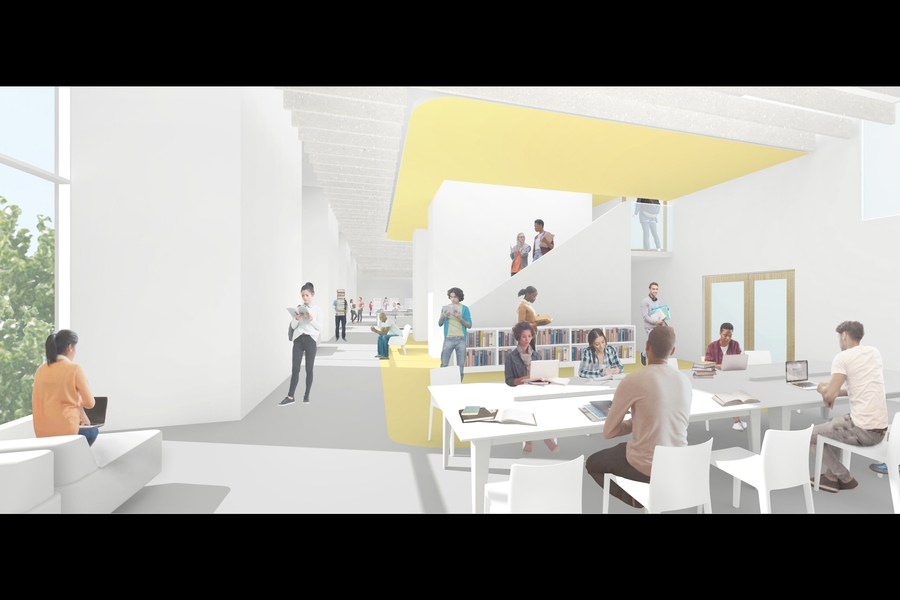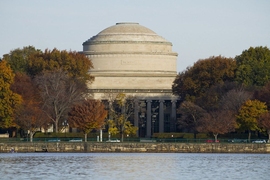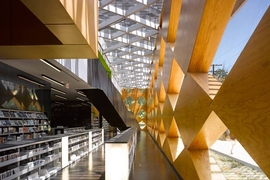The MIT Libraries, working with Kennedy & Violich Architecture (KVA), have developed the design for the upcoming Hayden Library renovation. As seen in architectural concept renderings, the new design accommodates the library’s multiple uses with dynamic areas for collaboration, research, and community-building, as well as quiet study.
Reopening in fall 2020, the renovated library will include a transformation of the first floor and parts of the second floor. New research and event program space, infrastructure upgrades, and improved accessibility will better support the ways that today’s MIT community uses library space. If donor funding is secured, Lipschitz Courtyard, adjacent to Hayden, will also be renovated concurrently with the library to provide a compelling outdoor community green space with new landscaping and seating areas.
“We asked KVA to create spaces that reflect the library of the future — participatory, creative, dynamic — while also preserving what makes Hayden such a popular study destination: quiet, restful space with beautiful views,” says Chris Bourg, director of the MIT Libraries. “Their design will not only make the library more open and welcoming; it will invite community members to make connections between ideas, collections, and each other.”
Research crossroads
KVA’s design concept for Hayden Library, “Research Crossroads,” is designed to enable new ways to study, collaborate, and conduct research with the library’s collections. The first floor has been designed as a dynamic and flexible community space for research and dialogue, where a new café, event space, and reservable study rooms will encourage impromptu gatherings, collaborative study, and community events. Two new double-height pavilion structures, clad in translucent glass and ash wood, are located in an X-shaped configuration that opens up views to the Lipschitz Courtyard and the Charles River.
“The Research Crossroads design concept was guided by the inspiring new vision for Hayden that MIT Libraries has developed,” says Sheila Kennedy, founding principal of KVA and professor of architecture in MIT’s School of Architecture and Planning. “The new design and renovation project will help bring the physical spaces of Hayden into a future where research collaboration and inclusive community building are becoming increasingly important.”
“This design puts research physically and figuratively at the center of the library,” says Bourg. “The research rooms will be visible as you enter, signaling that the library is an active and vibrant space where people are interacting with knowledge and each other.”
The entire first floor of the new Hayden, more than 10,000 square feet of space, will be accessible 24 hours a day to anyone with an MIT ID. The first and second floors of the library will be connected with an expanded new elevator and a new public stair and circulation path. At the east end of the first floor, a flexible event and teaching space can be configured in different ways to host events ranging from lectures to book signings, as well as library workshops and classes.
The second-floor reading room will remain a place for quiet study, suffused with natural light and featuring river views. Adjacent to the reading room will be staff offices for subject librarians and experts in scholarly communications, with areas for consultation with MIT students, faculty, and researchers. New flexible work space on the east side of Building 14’s second floor will provide additional space for study, research, and working with library collections.
Accessibility and sustainability
Access and sustainability have been priorities throughout the design process. An accessible, full-size elevator, the removal of non-accessible mezzanines, and the addition of new gender-inclusive restrooms and a lactation room will all contribute to a more inclusive and welcoming library. In addition to aiming for Leadership in Energy and Environmental Design Gold certification, the Hayden renovation will also be piloting two new certifications for MIT: Fitwel, a building certification focused on positive impacts for occupant health and wellbeing, and an interior design strategy that uses environmentally responsible materials.
To realize this vision for the new Hayden, the library will be closed from mid-December until fall 2020. Access to the basement-level general collections will close on Dec. 15, and all study spaces (including the 24-hour space) close on Dec. 19 at 5 p.m.
An exhibit about the Hayden Library renovation opens in the Maihaugen Gallery (14N-130) in December and will remain on view throughout construction.













